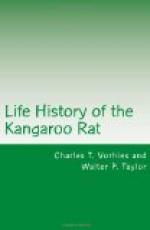[Illustration: PLATE IV. FIG. 1.—RANGE CONDITIONS FAVORING KANGAROO RATS.
View on higher portion of Range Reserve, showing type of country where Dipodomys s. spectabilis is most abundant. Good growth of grama and needle grasses in October, following summer growth and before grazing off by cattle and rodents.]
[Illustration: PLATE IV. FIG. 2.—RANGE CONDITIONS LESS FAVORABLE TO KANGAROO RATS.
View on lower portion of Range Reserve, where Dipodomys s. spectabilis is less abundant. Vegetation consists principally of Lycium, mesquite, rabbit brush, and cactus, there being very little grass.]
HABITS.
EVIDENCE OF PRESENCE.
MOUNDS.
One traveling over territory thickly occupied by the banner-tailed kangaroo rat is certain to note the numerous and conspicuous mounds so characteristic of the species, particularly if the region is of the savannah type, grassy rather than brushy. These low, rounded mounds occupy an area of several feet in diameter, and rise to varying heights above the general surface of the surrounding soil, the height depending rather more upon the character of the soil and the location of the mound as to exposure or protection than upon the area occupied by the burrow system which lies within and is the reason for the mound.
A den in sandy soil in the open may be of maximum size in area occupied and yet scarcely present the appearance of a mound in any sense, due probably both to the fact that the sandy soil will not heap up to such a height over a honeycomb of tunnels as will a firmer or rocky soil, and also to its greater exposure to the leveling action of rains and the trampling of animals. These mounds are in themselves large enough to attract some attention, but their conspicuousness is enhanced by the fact that they are more or less completely denuded of vegetation and are the centers of cleared areas often as much as 30 feet in diameter (Pl. V, Fig. 1); and further that from 3 to 12 large dark openings loom up in every mound. The larger openings are of such size as to suggest the presence of a much larger animal than actually inhabits the mound. Add to the above the fact that the traveler by day never sees the mound builder, and we have the chief reasons why curiosity is so often aroused by these habitations.
On the Range Reserve the mounds are usually rendered conspicuous by the absence of small vegetation, but Nelson writes that in the vicinity of Gallego, Chihuahua, they can be readily distinguished at a distance because of a growth of weeds and small bushes over their summits, which overtop the grass. In the vicinity of Albuquerque, N. Mex., Bailey reports (and this was recently confirmed by Vorhies) that the mounds about the holes of spectabilis are often hardly noticeable. Hollister writes




